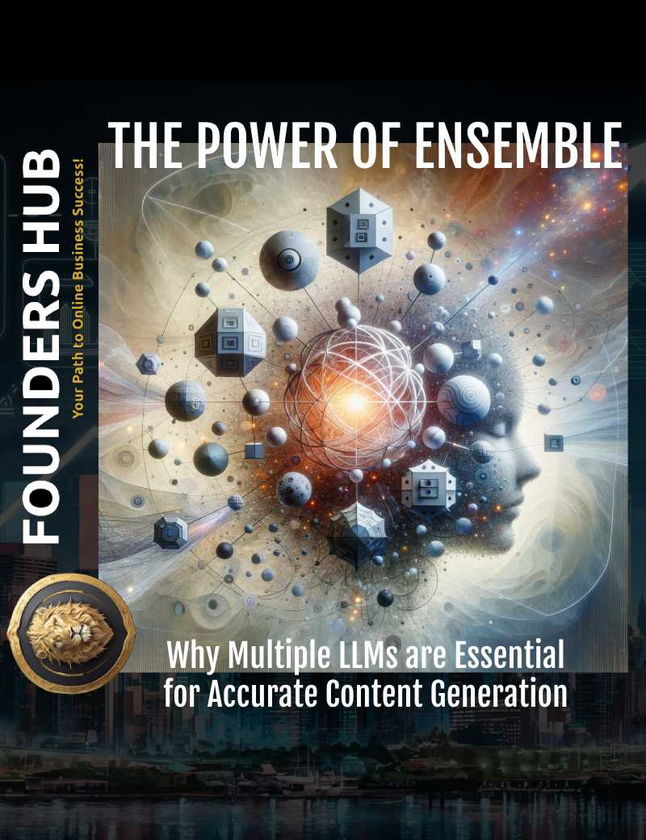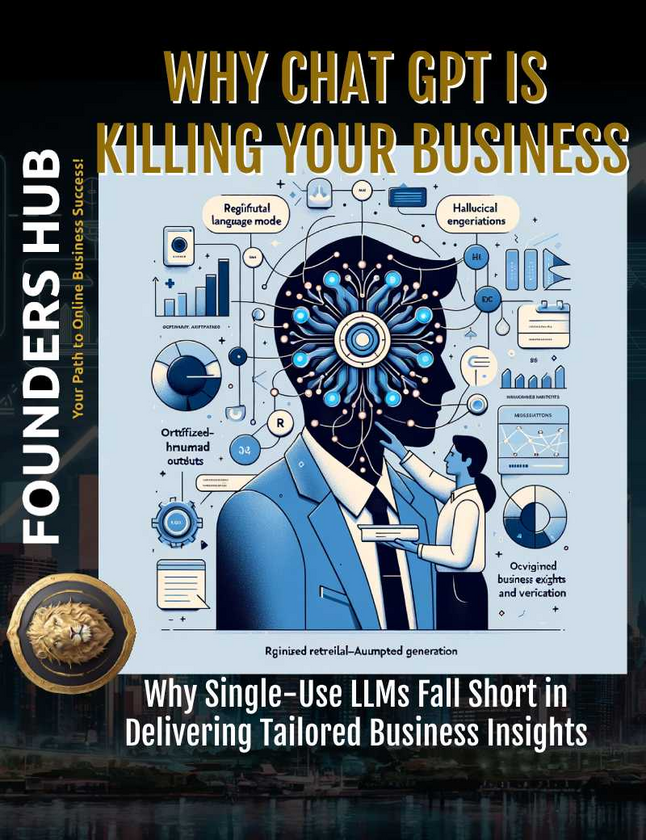In the rapidly evolving landscape of artificial intelligence, Large Language Models (LLMs) have emerged as a game-changer, revolutionizing the way we generate and consume content. From writing articles and reports to crafting creative narratives and even coding, these powerful models have demonstrated an unprecedented ability to produce human-like text. However, as we increasingly rely on LLMs for critical tasks, ensuring the accuracy and reliability of their outputs has become paramount.
Key Takeaway: Combining multiple LLMs through ensemble methods can significantly enhance the accuracy and robustness of content generation, mitigating the risks of bias and errors that often plague individual models.
The Rise of LLMs and the Need for Accurate Content Generation
Large Language Models are a type of artificial intelligence that uses deep learning techniques to analyze and generate human-like text. These models are trained on vast amounts of data, allowing them to understand and produce text with remarkable fluency and coherence. From automating customer service interactions to generating news articles and creative writing, LLMs have proven their versatility across a wide range of applications.
As businesses and organizations increasingly embrace generative AI, the demand for accurate and reliable content has skyrocketed. In industries such as healthcare, finance, and legal, where the consequences of inaccurate or biased information can be severe, the need for trustworthy content generation is paramount. Moreover, with the rise of misinformation and the growing importance of ethical AI practices, ensuring the integrity of LLM outputs has become a critical concern.
The Power of Ensemble Methods
Ensemble methods, a concept borrowed from machine learning, offer a promising solution to the challenges of accuracy and bias in LLM-generated content. By combining the outputs of multiple LLMs, ensemble approaches leverage the strengths of different models while mitigating their individual weaknesses.
Improved Accuracy and Robustness
One of the primary advantages of ensemble methods is their ability to enhance the overall accuracy and robustness of content generation. Each LLM has its own unique strengths and weaknesses, influenced by factors such as the training data, architecture, and optimization techniques used. By combining the outputs of multiple models, ensemble approaches can capitalize on the collective strengths while minimizing individual weaknesses.
For example, one LLM may excel at capturing nuanced language patterns, while another may be better at maintaining coherence and logical flow. By combining their outputs, the resulting content can benefit from the strengths of both models, leading to more accurate and coherent text generation.
A study by researchers at Google demonstrated the effectiveness of ensemble methods in improving the performance of LLMs. By combining the outputs of multiple models, they achieved a significant reduction in perplexity scores (a measure of how well a model predicts the next word in a sequence), indicating improved accuracy and fluency.
Mitigating Bias and Errors
Beyond enhancing accuracy, ensemble methods also play a crucial role in mitigating the risks of bias and errors in LLM-generated content. Individual LLMs can exhibit biases and errors due to factors such as historical human biases present in the training data or incomplete or unrepresentative datasets.
By combining multiple LLMs, ensemble approaches can diversify the outputs and reduce the impact of individual model biases. For instance, if one LLM exhibits gender bias in its language, another model with a more balanced representation can counteract this bias, resulting in a more equitable and unbiased output.
A study by researchers at the Allen Institute for Artificial Intelligence (AI2) found that ensemble methods effectively reduced gender bias in LLM-generated text. By combining the outputs of multiple models trained on different datasets, the ensemble approach produced more gender-neutral language compared to individual models.
Causes of Bias and Errors in LLMs
To fully appreciate the power of ensemble methods in mitigating bias and errors, it is essential to understand the underlying causes of these issues in LLMs.
Historical Human Biases
One of the primary sources of bias in LLMs is the historical human biases present in the training data. LLMs are trained on vast amounts of text data, which often reflects the biases and prejudices present in human-generated content. These biases can manifest in various forms, such as gender stereotypes, racial biases, or ideological leanings.
For example, if an LLM is trained on a dataset that contains a disproportionate representation of certain demographics or perspectives, it may perpetuate those biases in its generated content. This can lead to harmful stereotypes, misrepresentations, or even the propagation of discriminatory language.
Incomplete or Unrepresentative Training Data
Another significant challenge in ensuring accurate and unbiased LLM outputs is the issue of incomplete or unrepresentative training data. While LLMs are trained on vast amounts of data, it is often difficult to ensure that the training dataset is truly representative of the diversity and complexity of human language and experiences.
Certain topics, domains, or perspectives may be underrepresented or entirely absent from the training data, leading to gaps in the model's knowledge and understanding. This can result in inaccuracies, biases, or even nonsensical outputs when the LLM encounters unfamiliar contexts or scenarios.
For example, an LLM trained primarily on English-language data may struggle to generate accurate and culturally appropriate content for non-English languages or contexts. Similarly, an LLM trained on a limited domain, such as news articles, may perform poorly when tasked with generating content in a highly specialized field like medicine or law.
Mitigation Strategies with Ensemble Methods
While the challenges of bias and errors in LLMs are significant, ensemble methods offer powerful mitigation strategies to address these issues.
Human Intervention and Review
One crucial aspect of responsible AI practices is the involvement of human experts in the content generation process. By incorporating human intervention and review mechanisms, organizations can ensure that LLM-generated content is thoroughly vetted and corrected before dissemination.
Human reviewers can identify and address potential biases, inaccuracies, or inappropriate content that may have slipped through the ensemble models. Their expertise and contextual understanding can provide a critical layer of oversight, ensuring that the final output meets the highest standards of accuracy, fairness, and ethical considerations.
A notable example of successful human intervention in LLM-generated content is the work done by the Associated Press (AP). The news agency has implemented a system where human editors review and refine AI-generated content before publication, ensuring that the articles meet journalistic standards and are free from biases or errors.
Continuous Evaluation and Feedback Mechanisms
In addition to human intervention, implementing continuous evaluation and feedback mechanisms is essential for maintaining the accuracy and fairness of LLM-generated content over time. As language and societal norms evolve, it is crucial to regularly assess and update the models to ensure they remain relevant and unbiased.
Feedback loops that involve end-users, subject matter experts, and stakeholders can provide valuable insights into the performance and shortcomings of the LLM ensemble. This feedback can then be used to refine the models, update the training data, or adjust the ensemble configurations to better align with the desired outcomes.
Moreover, continuous evaluation can help identify emerging biases or errors that may arise as the models are exposed to new contexts or domains. By proactively addressing these issues, organizations can maintain the integrity and trustworthiness of their LLM-generated content.
Conclusion
In the era of generative AI, the power of ensemble methods in combining multiple LLMs cannot be overstated. By leveraging the collective strengths of different models, ensemble approaches offer a robust solution to the challenges of accuracy, bias, and errors that often plague individual LLMs.
As businesses and organizations increasingly rely on LLM-generated content, the need for accurate and reliable outputs becomes paramount. Ensemble methods not only enhance the overall accuracy and robustness of content generation but also play a crucial role in mitigating the risks of bias and errors stemming from historical human biases or incomplete training data.
However, responsible AI practices are essential to ensure ethical and unbiased outcomes. Human intervention and review, coupled with continuous evaluation and feedback mechanisms, provide a critical layer of oversight and refinement, ensuring that the final content meets the highest standards of accuracy, fairness, and ethical considerations.
Looking ahead, the future of AI-assisted content generation lies in the seamless integration of ensemble methods and human expertise. As LLMs continue to evolve and become more sophisticated, the need for robust ensemble approaches and responsible AI practices will only grow more pressing. By embracing these strategies, we can unlock the full potential of generative AI while safeguarding the integrity and trustworthiness of the content we consume.
FInd out more about how you can activate the full benefits of multi modal LLM applications for your business



















